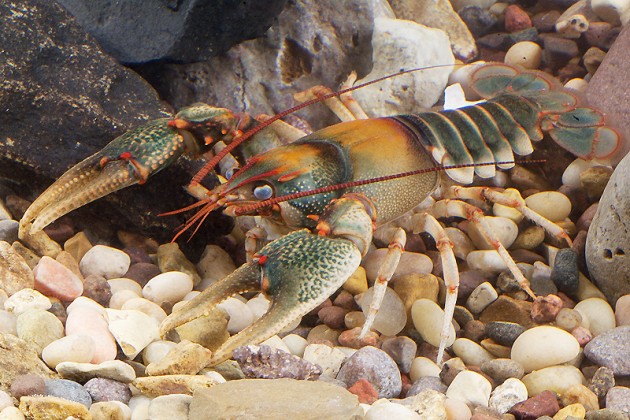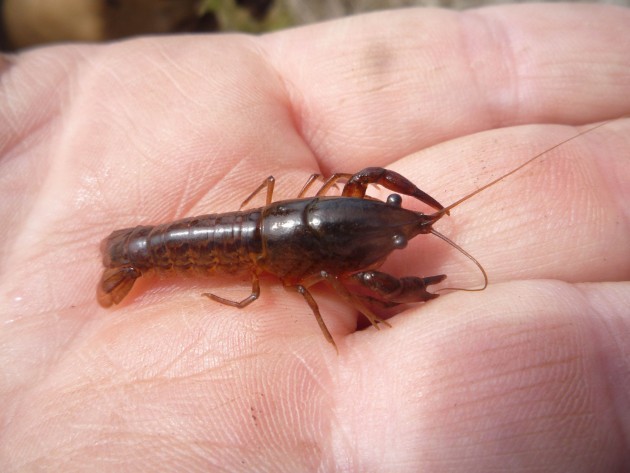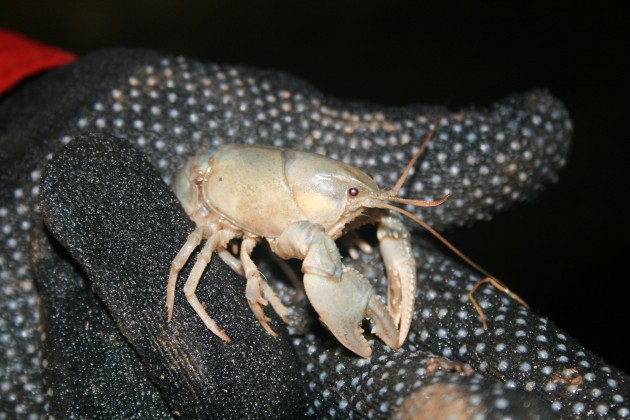By John Barrat

The Chattooga River crayfish is known from about 20 locations in the Chattooga River system in northwestern Georgia and northeastern Alabama. The small range of this species and poor land use practices within that range are potential threats to the Chattooga River crayfish. (Caption info: Georgia College.Flickr photo by Guenter Schuster, Eastern Kentucky University)
Yabbies, mudbugs, crayfish, crawdads, call them what you will, but one-third of the world’s crayfish species are facing extinction according to a recent report by a team of 40 international scientists.
“Most people are familiar with the Louisiana red swamp crawfish, the one you get at restaurants, but there are some 420 other species of crawfish found across the U.S,” says Keith Crandall, a study co-author from the Smithsonian’s National Museum of Natural History and the biology department at George Washington University.
The Southeastern United States, in fact, is the word’s hotspot for crayfish diversity. More than half of the 640 crayfish species around the world live in Tennessee, Alabama and Mississippi.

The Panama City crayfish is part of a fragmented population that Florida Fish and Wildlife Commission biologists are trying to help through restoration and management of their natural wet flatwoods habitat. They are only found in the Panama City area of Bay County, in Northwest Florida. (Flickr photo by Amy Raybuck)
Some 280 million years ago crayfish separated from saltwater lobsters and spread out into freshwater streams and lakes across North, Central and South America, Australia and Europe, Crandall explains.
Isolated in remote springs and mountain streams, many unique species developed, thriving in restricted areas, such as the headwaters of a single creek or a single cave.

A Lamington Blue crayfish, a native of Lamington National Park in Queensland, Australia. (Flickr photo by Tatters)
“A small environmental disturbance can have a massive impact on a species, potentially wiping it out,” Crandall says.
Crayfish are in trouble in the U.S. because their limited home ranges are under increasing stress from humans. With human density projected to increase in North America, continued loss and degradation of habitat—urban development, pollution, agriculture, damming and water management—is likely to increase extinction rates, the scientists say.
A second world hot spot of crayfish diversity is in Australia, where many species are at risk from climate change. These Australian crawfish species live at headwaters of streams in the higher altitude rainforest where it is cooler, says Crandall. Global warming is impacting those habitats, making them warmer and unsuitable for native species.
Converting natural land to agricultural use in Australia has also increased the rate of irrigation, prompting water shortages and salinization of freshwater wetlands. Invasive species such as wild pigs and cane toads also eat young crayfish and destroy stream habitats there.
European crayfish face the greatest number of threats;the most widespread threat is invasive crayfish species, the scientists say in their study. Rising temperatures have facilitated the spread of invasive crayfish that compete and drive out native crayfish, as well as a fungal infection known as the crayfish plague.

Live yabbies (Australian for crayfish) for sale at Yanni’s Seafood and Oyster Spot, Queen Victoria Market, Melbourne, Australia (Flickr photo by Alpha)
Freshwater ecosystems occupy less than 1 percent of the earth’s surface, but support approximately 10 percent of the world’s species and 30 percent of all vertebrates, the scientists point out. Still, freshwater species, particularly invertebrates like crayfish, are a low priority on the conservation agenda.
Conservation measures taken now to protect crayfish and their habitats would have positive impact on a number of other freshwater species, such as fish, mollusks and dragonflies.
Freshwater ecosystems provide a range of valuable services, the report states, yet human demand on these resources is leading to a freshwater biodiversity crisis.
“There is growing evidence that freshwater taxa are at a greater risk of extinction than terrestrial vertebrates,” the researchers report.






